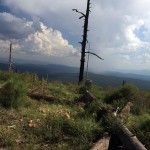Salvage Logging Can Reduce Danger For Decades
Posted: June 16, 2016Source: Payson Roundup

Photo by PeteAleshire
Massive fires that rage through the ponderosa pine forest leave a haunted wasteland in their wake.
To find a stunning example, just drive on Forest Road 300 through the blackened scar of the Dude Fire, which charred 30,000 acres and killed six firefighters more than 20 years ago. Many of the blackened snags still stand, many more lie piled on the ground like jackstraws.
But at least the burn area forms a firebreak. Right?
Not necessarily.
A tree-killing fire actually increases the amount of readily burned fuel on the ground for 20 years or more,
according to a recent study by the Forest Service’s Pacific Northwest Research Station published in the Journal Forest Ecology and Management.
The study gives support for the controversial practice of salvage logging, which gives timber companies the go-ahead to move in quickly after a wildfire to harvest the dead and downed trees killed — but not consumed — by the fire.
Current Forest Service practice often requires a detailed, time-consuming study before timber companies can go in and harvest the dead and dying trees. Often, this results in the “bluing” of the wood and the onset of rot and decay, These natural processes can make the lumber all but worthless by the time the Forest Service approves the salvage logging project.
However, the study of the long-term effects of salvage logging offers strong new support for the practice. The researchers sampled 255 forest areas killed by wildfires in Oregon and Washington between 1970 and 2007. That included 96 stands that underwent post-fire salvage logging and 159 stands that did not.
The researchers studied a series of wildfires decades after the burn. They compared areas that underwent salvage logging to areas where the dead and dying trees were left alone.
The unlogged stands had relatively low fuel loads right after the fire, but the downed wood still ready to burn built up steadily for the next 20 years. The greater amount of wood on the ground remained measurable for 40 years after the burn.
In the logged stands, the amount of brush and wood and debris on the ground increased right after the fire. That’s probably because the loggers harvested the trunks of the trees, but left behind branches and other debris. After that, the amount of fuel on the ground declined steadily and significantly — without the slow death and toppling of the big trees killed by the initial fire.
The study just looked at the impact of salvage logging on the amount of wood and debris left behind. They did not consider other potentially important impacts like erosion, wildlife habitat and how the forest looked. Some of the objections to post-fire salvage logging have centered on those issues, including the damage done to soils by having heavy equipment move in after a fire to harvest the dead and dying trees.

